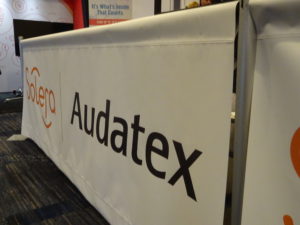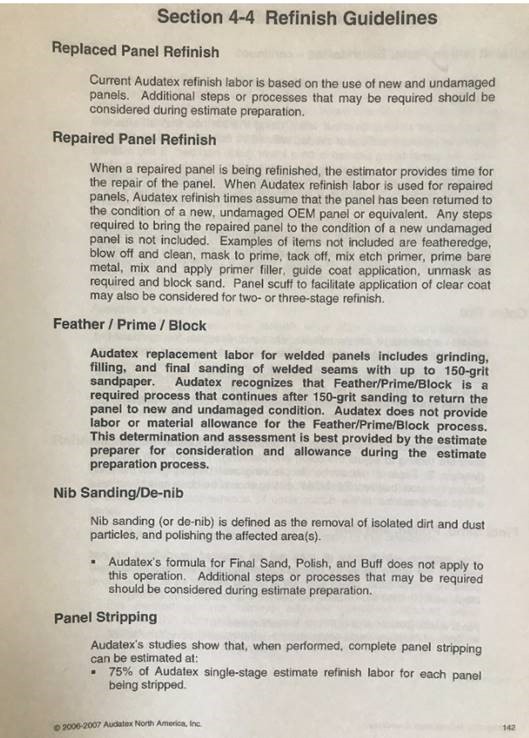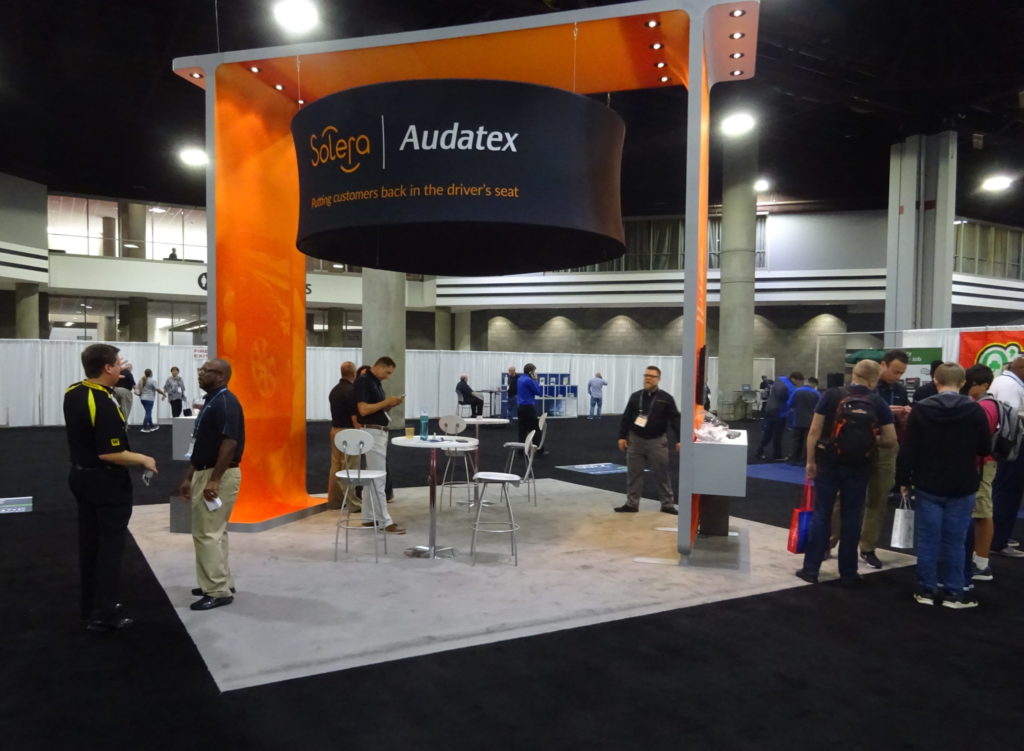
Audatex’s 180-degree turn on feather, prime, block draws questions of labor time accuracy
By onAssociations | Business Practices | Market Trends | Repair Operations | Technology
In addition to highlighting an inconsistency in Audatex’s 2015 feather, prime and block feature, the Society of Collision Repair Specialists has demanded more information on how a significant FPB policy shift had affected labor times.
SCRS said it became aware of Audatex’s complete reversal on welded panel feather, prime and block more than a decade ago during recent research.
As of 2007, Audatex had declared feather, prime and block not included within its times for replacing a welded panel.
“Audatex replacement labor for welded panels includes grinding, filling and final standing of welded seams with up to 150-grit sandpaper,” Audatex wrote in its 2007 Database Reference Manual. “Audatex recognizes that Feather/Prime/Block is a required process that continues after 150-grit sanding to return the panel to new and undamaged condition. Audatex does not provide labor or material allowance for the Feather/Prime/Block process. This determination and assessment is best provided by the estimate preparer for consideration and allowance during the estimate preparation process.”
According to SCRS, this echoes the position the Collision Industry Conference held in 2006:
“Feather, prime and block are not-included refinish operations that complete the process from 150 grit to the condition of a new undamaged panel,” the CIC Estimating Committee wrote in the final version. (What appears to be an earlier version of the CIC text is also included in Audatex’s 2019 DBRM, the most current as of press time.)
“The refinish process starts at the condition of a new undamaged panel and is outlined and documented in printed and/or electronic time guides.
“The body / paint labor and materials necessary to prepare the repaired area from 150 grit to the condition of a new undamaged part is a valid and required step in the process. The labor and material allowance for these operations requires an on the spot evaluation of the specific vehicle and damage.”
However, Audatex’s 2007.5 Database Reference Manual deletes the reference to welded panels and speaks only of repaired panels.
“Audatex recognizes that Feather/Prime/Block are required operations in the panel repair process, that occurs after 150 grit, to bring the repaired panel to the condition of a new, undamaged panel for the purpose of refinish,” it wrote. “Audatex does not provide labor allowance for repaired panels, as this is a judgment time, nor does Audatex provide material allowance for the Feather/Prime/Block process. The determination and assessment for this operation is best provided by the estimate preparer for consideration and allowance during the estimate preparation process.”
In 2008, Audatex told the Database Enhancement Gateway that labor times for welded replacement panels included feather, prime and block.
“The Audatex labor allowances for a welded replacement panels includes the following operations body fill labor,Block sand, Application of guide coat, and Dual action sand required to bring the welded seams areas to to new undamaged condition per the 2008-2009 Database Reference Manual section 4-3 Replacement & Recycled Operations and 4-5 Refinish Operations,” Audatex replied to a user asking about a 2004 Pontiac Grand Am. “The reference to 150 grit finishing of a panel only applies to a panel that is repaired not a panel that has been replaced as per Section 4-4 Refinish Guidelines Feather/Prime/Block.”
The user in November 2008 had asked about an Audatex statement “THAT THE FILL AND BLOCK SAND IS INCLUDED” on a welded quarter panel.
“HOWEVER THE P-PAGES DO NOT STATE TO WHAT GRAIN OF SAND PAPER IS THE FINISH PRODUCT OF THE SPOT WELDS AND SEAM WELDS,” the user wrote. “BOTH OF THE OTHER MAJOR DATA BASES GIVE REFERENCE TO WELDS AND SEAM WELDS TO BE FINISHED TO 150 GRIT. THE REFINISH TIME IS STATED TO START AT 320.”
The user had proposed that a gap existed “IN THE VARIABLE THAT NOT ALL WELDS WOULD NEED TO BE FINISHED” past 150 grit if they weren’t visible.
Audatex continues to call feather, prime and block labor not-included on repaired panels but included in welded panel replacement times. (Though it says materials aren’t included in either sets of times.)
“Audatex recognizes that Feather/Prime/Block are required operations when replacing welded-on panels,” Audatex writes in the 2019 Database Reference Manual, the most recent as of press time. “Time to perform this operation is included in the Audatex time for welded panel replacement in the seamed areas, to bring the panels to the condition of a new, undamaged panel for the purpose of refinish. Although the time is included, Audatex does not provide a material allowance for the Feather/Prime/Block process. If necessary, the determination and assessment for materials is best provided by the estimate preparer for consideration and allowance during the estimate preparation process.”
This 180-degree turn on what Audatex had in 2007 called a matter “best provided by the estimate preparer for consideration and allowance during the estimate preparation process” raises the question of whether repairers saw an increase in all of Audatex’s existing welded panel labor times.
SCRS said it inquired if Audatex could “prove that the shift in positioning, was accompanied by a shift in all previous welded replacement times from 2007 – 2008?
“… If not, did Audatex actually start including the previously non-included labor? Or simply state that they did, to inhibit repair facilities from being able to capture it?”
SCRS says it has never received an official answer to either question.
Audatex did discuss time accuracy in a Sept. 11, 2019, response to SCRS, but SCRS later clarified that the organization had been asking about what it saw as an inconsistency in Audatex’s feather, prime and block feature.
“I can assure you on behalf of Solera that we are earnestly working on FPB,” Audatex wrote last year. “Since our last discussion, we have made consistent progress. Solera has worked with multiple shops in the DFW area. During our onsite shop reviews, we performed in-depth time studies on repairs that include FPB across different vehicle brands and types. Replacement operations included but were not limited to quarter panels, rocker panels and rear body panels. During these studies the team referred to Audatex’s list of included operations for each specific vehicle. In addition, they referred to the manufacturers repair information to ensure the accuracy of our database. The development team is currently analyzing Audatex internal labor and refinish methodologies to ensure we are aligned with industry trends. We understand the importance and urgency of this topic. Going forward we will provide regular communications. As of now there is no change in the status as we work through the topic of FPB to make certain we address the topic accurately and with supporting research.”
We asked Audatex parent Solera about the rationale behind the 2007-08 change. Mentioning SCRS’ questions and assertion, we also asked how Audatex went about changing all prior welded panel replacement times to reflect its new position, for any proof that all times increased back then, and for a description of how Audatex has studied and included the labor since back then.
Solera provided the following response to address these questions and our separate look into the feather, prime and block inconsistency.
We appreciate this opportunity to respond to Repair Driven News’ inquiry. Our team of experts at Solera work hard to ensure that our estimating products provide a valuable benefit to the repair industry by enabling fair and accurate repair estimates. We bring the industry comprehensive tools that provide detail while also being efficient to use.
We appreciate organizations in the repair industry, such as SCRS, that raise concerns of and seek clarity for their members. We have worked closely with SCRS and other industry organizations over the years to implement enhancements to our estimating solutions. As to the questions that SCRS has raised about Feather, Prime and Block in the Audatex estimation product, we have reviewed the matter with SCRS in multiple discussions, including meetings at our corporate headquarters. We pointed out to SCRS in 2015 that our product was updated as the industry’s perspective of the Feather, Prime and Block process developed.
We take all industry participants’ suggestions for improvement of our product seriously, but not all suggestions are ultimately incorporated into our products. We recognize that some members of SCRS would prefer that our products detail, as a line item, the time involved in the Feather, Prime and Block processes relating to replacement of welded-on panels. That is not an option currently available in our product. The time involved in the Feather, Prime and Block operations is included in the overall labor time.
Our current database reference manual, points this out, stating “Audatex recognizes that Feather/Prime/Block are required operations when replacing welded-on panels. Time to perform this operation is included [emphasis added] in the Audatex time for welded panel replacement in the seamed areas, to bring the panels to the condition of a new, undamaged panel for the purpose of refinish. Although the time is included, Audatex does not provide a material allowance for the Feather/Prime/Block process. If necessary, the determination and assessment for materials is best provided by the estimate preparer for consideration and allowance during the estimate preparation process.”
We recognize some repairers consider Feather, Prime and Block as part of the preparation for paint while others consider it as part of the welding repair operation. Our system, as explained in our reference manual, considers the process as part of the welding repair operation and includes the time for the process in the time allotted for the for the welded panel replacement.
We periodically review the times allotted and engage experts to conduct time studies to confirm that the times in our products, such as the times for replacement of welded parts are appropriate for all included operations, whether or not such operations are listed as a line item on the estimates. As we explained to SCRS in September 2019, we specifically worked with multiple shops and performed in-depth time studies on repairs that included Feather, Prime and Block operations.
You probably noted that SCRS does not question whether the time allotted for the welded panel operation is sufficient. Instead, the questions are about changes to our product documentation and methodology. Those questions should not overshadow the fact that no one has questioned the sufficiency of the repair times in our product to include the stated operations. We take pride in ensuring that we provide accurate times for repair and replacement processes.
Our products – and their documentation – will continue to evolve. The automotive landscape is constantly changing. Vehicles and their systems as well as the tools used for repair are continuously improving. Our goal is to produce products that empower our customers to work efficiently in the complex repair industry. Solera has always been willing to review, adjust and improve our products to align with changing industry conditions and best practices, and we will continue to do so.
More information:
2019 Audatex Database Reference Manual (most current as of June 5, 2020 press time)
Images:
The Audatex and Solera brands can be seen at Connected Car Insurance USA 2018. (John Huetter/Repairer Driven News)
Audatex’s 2007 Database Reference Manual lists feather, prime and block on welded replacement panels as not-included. (Provided by Audatex)
Audatex’s NACE 2018 booth is shown. (John Huetter/Repairer Driven News)


